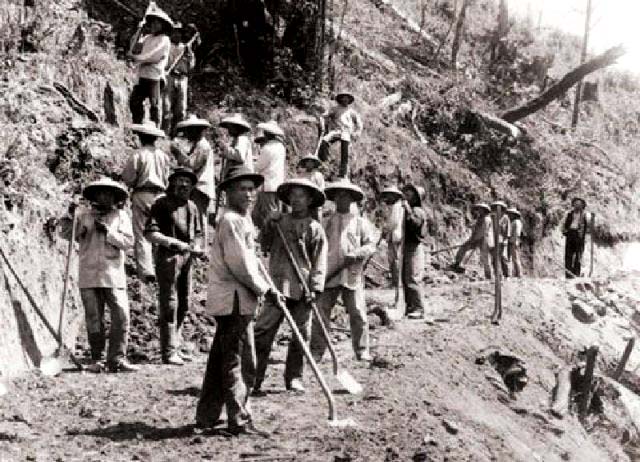
2012
|


Workers construct a railway grade - Date/Photographer unknown.
11 July 2012
Chinese Artifacts Depict Harsh Beginnings
Port Moody British Columbia - It is a sad reminder of a time long gone. Mahjong tiles, opium pipes, coins, and incense burners are just
a few rare artifacts from a period of time when Chinese people faced intense discrimination and hardships in the Tri-Cities.
But the Revelstoke Railway Museum hopes Port Moody residents never forget the sacrifices made by thousands of Chinese immigrants who helped build the Canadian
Pacific Railway.
"Chinese Legacies: Building the Canadian Pacific Railway", a travelling collection created by the Revelstoke Railway Museum and the Revelstoke
Museum and Archives, is now on display at the Port Moody Station Museum.
It features a haunting display and detailed photographic account of the thousands of Chinese workers who helped build the section of the Canadian Pacific
Railway from Port Moody to Kamloops between 1881 and 1885.
"People remember the glory aspects of (building the railway), the Last Spike and the first train," said Rebecca Clarke, the Port Moody Station Museum
coordinator. "But people tend to forget the hardships of all the workers and what they went through to make it happen."
When construction began in 1881, Chinese workers were recruited almost immediately to work on the 22,500-kilometre railway.
They were seen as cheap labour and were shipped from San Francisco and China to Port Moody before traveling to the construction site in the interior.
Chinese workers were paid half the salary of Caucasian workers, usually $1 a day, to do some of the most dangerous on-site work. In a year, they would earn
approximately $43 after deductions.
It is estimated that between 600 and 2,200 Chinese workers lost their lives within five years due to landslides, dynamite blasts, accidents, poor nutrition,
and illness.
Following the completion of the railway in 1885 when their services were no longer necessary, they worked intermittently on railways because they could not
find other work.
Some returned to China, while others moved to impoverished Chinatowns in Vancouver and Victoria.
"The exhibit broaches a somewhat controversial topic that doesn't shy away from relating the hardships and the prejudices that faced the Chinese workers
at a time in our history when, unfortunately, they were treated as second class citizens," said Jennifer Dunkerson, executive director of the Revelstoke
Railway Museum.
The arrival of immigrants from China also formed the basis of a large permanent Chinese community in the country, she added.
Now, the exhibit includes recreations of artifacts such as a clay sauce dish, tiger whiskey bottle, and soy jugs, which offer a rare glimpse into the lives of
approximately 15,000 Chinese labourers who worked on the CPR in the province.
"They had very little with them. Many of them being new immigrants who arrived without more than they could carry. Their low wage rate didn't give them an
opportunity to have much more than the basics of life while they were working," said Dunkerson.
Their simplistic lifestyle is also mirrored in the life-sized re-enactment of a labourer encampment at the museum.
While some people may have forgotten the contribution that Chinese workers made in Port Moody, the exhibit serves as a reminder of that part of the community's
150-year history.
"When people think of Chinese railway workers, they think more about the Interior, it is important that people realize it wasn't limited to one place,
they did come through Port Moody and helped create a piece of B.C. history," said Clarke.
The exhibit will be on display at the Port Moody Station Museum until 16 Nov 2012.
Kendra Wong.

|


|
Vancouver Island
British Columbia
Canada
|
|


